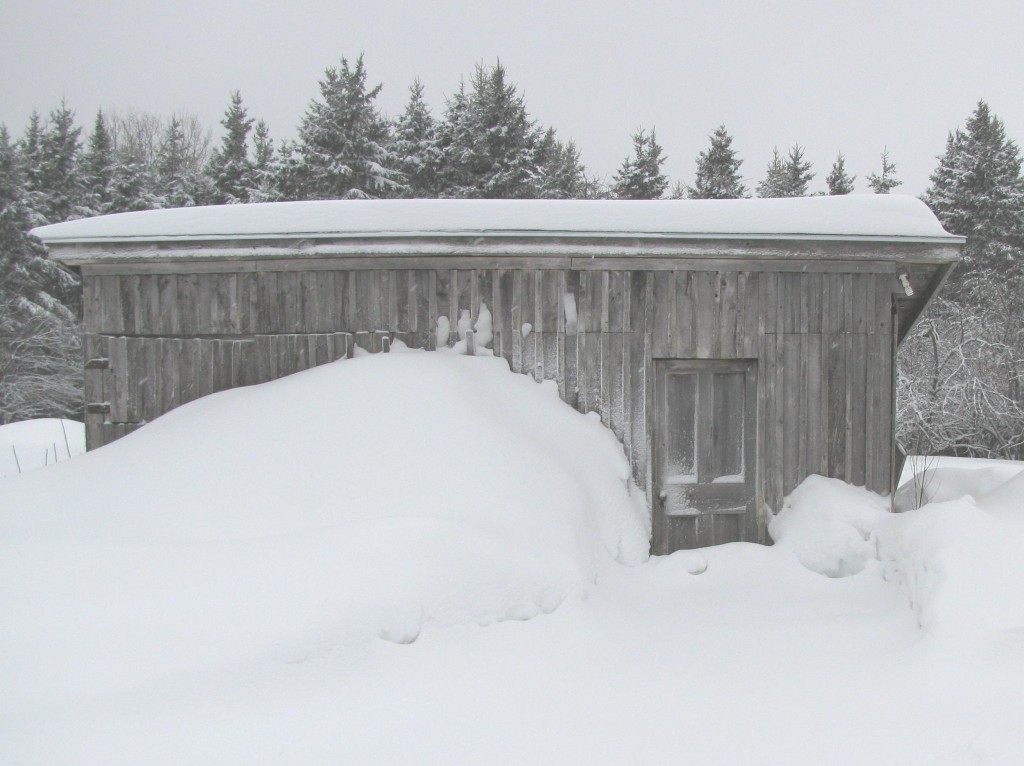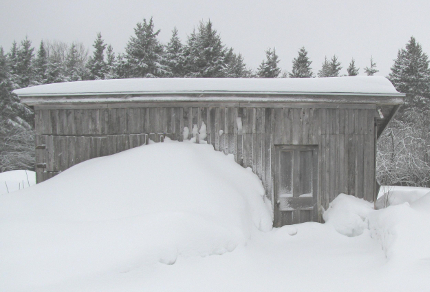
Chicken Coop After the Snowstorm (© Magi Nams)
Tufts within a rumpled blanket of white, drifts of new snow lay in cozy mounds against outbuildings this morning and licked across our winter access road like a line of voracious tongues intent on swallowing reflective snow markers already nearly buried by the weekly snowstorms we’ve experienced in northern Nova Scotia since our return from the tropics of Australia in late December. Vilis has had to insert additional red-topped wooden markers into the deep, packed drifts edging the road in order to guide his snowblowing efforts with the old David Brown tractor, a vital piece of equipment granting us free passage of the 800-metre road that winds through parkland meadows and hemlock forest, a large block of the latter devastated by recent clearcutting done by a logging company.
While in Australia, I learned that Oz has one of the highest rates of land clearance in the developed world; yet since our return to Nova Scotia, I’ve noticed numerous new clearcuts in the vicinity of our home, direct evidence of the Canadian forest industry’s overwhelming dedication to harvesting via clearcutting, which accounts for at least 90% of the timber harvesting done in the country despite well-documented evidence for destruction of wildlife habitat and drastic alteration of soil and water regimes.1 Only days after we returned to Ravenhill in the first snowstorm of the winter, with snow lying smooth and serene beneath towering hemlocks bordering our access road, the loggers moved in and destroyed the forest edging the far reaches of the road, that land not belonging to us. One day the forest was there; on the next, it was gone. I went for a walk that afternoon and, upon entering the scene of destruction, recognized nothing. I did not know where I was and stood gaping in shocked horror at the chaos of severed trunks and dismembered branches. The snowstorms since have shrouded the devastation with gentle curves of sweeping, cold disguise.
Such snowdrifts also disguise the denning sites of black bears, which we see occasionally on our land and whose droppings we more frequently encounter in the woods. Today, on CBC Radio One’s Quirks and Quarks weekly science program, I learned that new research done in Alaska by Dr. Craig Heller of Stanford University showed that hibernating black bears lower their body temperature in an oscillating pattern every few days, with their core temperature repeatedly dropping to 30°C and then creeping back up to 35-36°C, near normal. Even more intriguing was Heller’s finding that the metabolism of hibernating bears drops to only a quarter of their normal metabolic rate, which results in an astounding reduction of energy usage during the bears’ 5 to 7 months of hibernation – far greater than was previously thought.
So, somewhere beneath the shroud of white blanketing the devastated hemlock forest bordering my access road, a black bear may be resting deep in hibernation, only to find on its arousal that it, too, recognizes nothing.
References:
1. CPAWS-Wildlands League. Replace clearcutting with alternatives, group tells forestry industry. February 28, 2005, Toronto. http://www.nben.ca/environews/media/mediaarchives/05/mar/alternatives.htm
2. CBC Radio, Quirks and Quarks. Hibernating Bears. Saturday, February 26, 2011. http://www.cbc.ca/quirks/episode/2011/02/26/february-26-2011/


